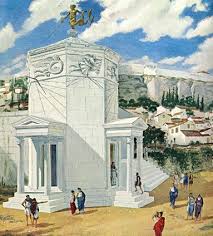Compass Rose
In the twisted maze
of emotional neuropathy
I search for a skylight
I need to read the stars
They are reminders of
sure footing on shaky ground
Constellations point
towards an inherent path
amid darkness that glitters
The depth of indefinite black
accentuates beauty found
Without it I would not know light
I search for markers in the sky
eyes raised towards
a destination unknown

A compass rose (or windrose or compass star or stella maris) is an 8-point design on a compass, map, nautical chart, non-directional beacon, GPS or VOR system, monument, etc. that displays the orientation of the cardinal and ordinal directions. The Greeks developed a system of cardinal points based on celestial bodies, used for orientation, and a different system of wind directions used for meteorology, but over time the two systems were conflated. Aristotle identified 10 distinct winds, but to restore balance Timosthenes of Rhodes added two more and began to use them to denote geographical direction for navigators, while Eratostenes deducted two from the Aristotelian system to establish the traditional eight points. Eventually, in the 9th century, Charlemagne designated the four cardinal winds with the Frankish terms "nord" (perhaps derived from the word for "wet"), ost (sunrise, shining place), vuest (dwelling place, evening), and sund (sunny lands) -- put them together in English and they spell "news."
ReplyDeleteAn old structure that was based on a version of the compass rose is the Tower of Winds, constructed in the Roman agora of Athens in the early 1st century BCE by Andronicus of Cyrrhus. The octagonal building functioned as a timepiece that combined sundials, a water clock, and a wind vane. Its 12-meter-plus height made it visible from afar, making it an early clocktower. It contained what were believed to be the remains of the father of Alexander the Great. In 1668 Evliya Celebi desrribed what the Turks referred to as Plato's pavilion:"It consists of a remarkable sort of stone tent, with eight sides facing the eight winds, each side formed from a single slab. On each of the sides of this pavilion a human figure is depicted, formed from a single piece of white marble. Each figure holds in his hands the characteristic implements of one of the winds. Four of the winds are depicted as male and four as female. The four males are shown with the moon-like features of a youth bright as the sun's rays, and the four women are portrayed as lovely creatures.....In truth it was the magic art that made these images so that each one stands facing one of the winds. The dome of the pavilion has been formed of white marble inside, and 12 compartments have been established there according to the 12 constellations of the zodiac.... Thus it is a unitary instructional pavilion built of marble, with twelve compartments where the influences of the seven planets and other heavenly bodies dependent on these constellations of the zodiac are determined and recorded at the level of manifest magic.... On the outside of this marble pavilion-dome there is a thin pivot, and in the days of the learned ancients they say that there was a mirror of the world set on this pivot.... And they say that whenever an enemy started out against the city from anywhere in the world, the enemy army, as it marched, was revealed along with its commander in this mirror of the world. The place for the mirror remains, but the mirror is no longer there. In those days also, each of the learned men in the city devised for it a different sort of strange talismanic protection, marvelous to relate. Each day, one of them created a talisman of surpassing wondrousness, so that in this city, it is said, there were no plagues, snakes, centipedes, scorpions, storks, crows, fleas, lice, bedbugs, mosquitoes or houseflies. To put it succinctly, at break of dawn on every one of the 366 days in a year, they threw one talisman on the ground, and one talisman of the sort associated with the sea into the sea.... And even now there are many places visible, which I have seen, where there used to be talismans. And for that matter, even now there are no mosquitoes, centipedes, storks or crows, and even if they come here, they do not settle down, and if they stay for long, they die. If a man enters the pavilion when he is feeling nauseated, he will be relieved within the hour, and will vomit up bits of black and yellow bile and phlegm, and other humors. This is because in one of the compartments of the dome there is a piece of Yemeni alum, and in another there is an azure-colored blue vitriol eye-stone. Likewise, by the effect of their odor, a feverish man, once he has vomited, will be cured of his fever."
ReplyDeleteA lovely, and for me, an emotional poem that pulls me into it
ReplyDelete